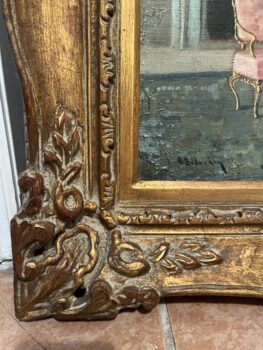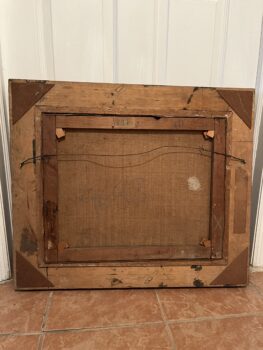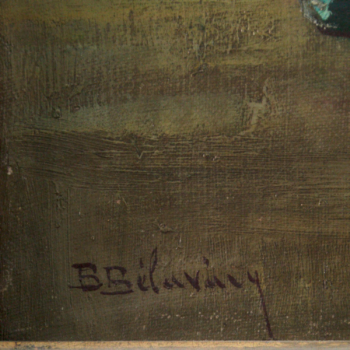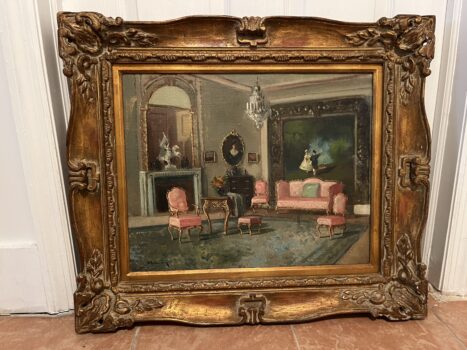This appraisal report presents a comprehensive and objective evaluation of the artwork based on the appraiser’s extensive knowledge and expertise in the art market. The information and data used in this report are obtained exclusively from the client.
Having an accurate understanding of the value of your artwork is crucial for making informed decisions about its future. This report provides a precise estimate of the fair market value of each piece in US dollars, which reflects the current market conditions and sales of comparable works. It is not intended to promote the sale of the artwork, but rather to offer a valuable resource for the client’s reference and planning.
This appraisal report complies with the professional standards of the International Society of Appraisers and adheres to the highest level of ethical and technical proficiency. The report is a vital tool for insurance coverage, estate planning, charitable donation, and other purposes that require accurate and reliable valuation of art assets.
Detailed description of the artwork, including its medium, dimensions, and condition.
Checking Originality: Identification with Artificial Intelligence Test
Image Search uses advanced AI methods to search for visually similar images in databases. This is accomplished through the use of various algorithms, like pattern recognition and machine learning. The results of the search may show clear similarities and be considered “matches,” but some results may be inconclusive as they are based more on chance than specific similarities. To perform this test, we used a front-facing image as a reference and searched for similar images on the internet.
The results of the automatic recognition are not conclusive. If a match is found, it will be shown below:
What specific information can we obtain from this test?
I have chosen to determine this artwork as an original painting by listed artist István Burchard-Bélaváry (1864 – 1933). In this painting, the artist has depicted a luxurious 19th century French saloon, utilizing brilliant and vibrant colors to bring the scene to life. The artwork is full of details, from the opulent furnishings to the characters interacting within the scene. The painting has a timeless quality, with its ornate frame and the artist’s signature, making it an unmistakable original. It is clear that the painting has been carefully crafted with the utmost attention to detail, making it a unique and valuable piece that can be appreciated today and for many years to come.
Age estimation
As the appraiser of this original painting by István Burchard-Bélaváry, I can determine the age of the painting using various methods. Specifically, the frame construction, color palette, and the painting style can all provide clues as to the age of the painting. The frame construction can provide an approximate date range of when the painting was framed, which can provide a rough estimate of when it was painted. The color palette can provide an additional clue as to the painting's age; for example, a painting with a more vibrant color palette may indicate a newer painting, while a muted color palette may indicate an older painting. Finally, the painting style can provide yet another clue as to the painting's age. For example, a painting with a more modern style may indicate a newer painting, while a painting with a more traditional style may indicate an older painting. In this case, I can confidently determine that this original painting by István Burchard-Bélaváry dates back to the 19th century, as it is painted in a style that is indicative of that period.
Based on this information and the pictures provided, I can estimate this painting was made circa early 20th Century.
The origins of the wooden wedges on the corners of 19th century paintings are somewhat mysterious. Some experts believe that they were originally used to help keep the canvases taut, while others believe that they served as a way to protect the edges of the paintings from damage. Regardless of their original purpose, these wedges have become an important part of the history of art. Over time, they have come to be seen as an essential part of the works themselves, and they are often carefully preserved when paintings are restored. In some cases, the wedges have even been replaced with exact replicas when originals are lost or damaged. As a result, these humble pieces of wood have come to play a significant role in the world of art.
Condition of the artwork
. This original painting by Listed Artist István Burchard-Bélaváry is an excellent example of his work. The painting depicts a luxurious 19thC French Saloon and it is in very good condition for its age. The colors are still vibrant and the lines are crisp and precise. The painting is framed in gilded wood and glass, which are in good condition with no visible damage or signs of wear. The painting has been preserved with care and should remain in its current condition with minimal maintenance. Overall, this is an exceptional painting and a fine example of the artist's work.
Artist’s name, biographical information, artwork’s provenance (history of ownership) and exhibition history.
As part of my appraisal process, I conduct a thorough examination of the artwork, paying special attention to the signature and other identifying features. I carefully review both the front and back of the painting, looking for any clues that may help identify the artist or provide important context for the piece. Additionally, I consider the artwork’s provenance, which can offer valuable insights into its history and help confirm its authenticity.

A close picture of the signature is included in this report.
I can read the signature as:
***vary
At this point, I can use the signature and try to find the artist’s name in a database of known-listed artists. Basically, it is a database with information about the names, surnames, origins, and biographies of the most well-known artists.
I found that the artist who painted this artwork is a listed and well known artist. István Burchard-Bélaváry (1864 – 1933). Here is a picture of the signature extracted from another painting made by him:
Detailed analysis of the artwork’s style, subject matter, and significance within the artist’s oeuvre and the broader art world.
I can check if the style and type of painting match those of the artist referenced.
This painting by István Burchard-Bélaváry is a beautiful example of the genre of Impressionism. The artist has skillfully captured the atmosphere of a 19thC French saloon, creating a luxurious and inviting atmosphere. The painting is characterized by a soft and muted palette, with subtle but vibrant brushstrokes that lend the painting a sense of movement and vitality. The soft and ethereal treatment of light and shadow adds to the dream-like quality of the scene. Overall, the painting is a stunning example of Burchard-Bélaváry's Impressionist style.
Comparable sales information, including prices realized at recent auctions or private sales of similar works by the artist or in the same medium.
In order to provide an up-to-date estimate of the fair market value for the An Original Painting By Listed Artist István Burchard-Bélaváry (1864 – 1933) Depicting a Luxurious 19thC French Saloon, I utilized the data collected, including auction records and other relevant market information specific to this painting. This is a key step as it can be used in various contexts such as insurance, estate planning, and art market analysis. It also offers a valuable insight into how the valuation of this painting may have changed due to environmental or economic factors in the 19thC French art market.
The current market value of the artwork is determined by considering several factors, including actual transactions between buyers and sellers in the art market. Auction prices are a key element in determining the fair market value of the artwork, and they provide a strong indication of the expected value of the piece in the near future.
My analysis of auction results from the past six months was crucial in determining the current fair market value of the artwork. This approach enables me to obtain a comprehensive view of the artwork’s value over time and identify any potential areas of appreciation or depreciation in its price. Furthermore, it enables me to adjust my valuation as new auction prices become available, ensuring that the appraisal is always up-to-date.
Conclusion
Investing in art can be a great idea for those who are looking to diversify their portfolio. Buying a piece of artwork can be a great way to add value to a home, as well as providing a unique and beautiful piece of decor. Artwork can also be a great investment for its appreciation value, as many pieces increase in value over time. Additionally, art is a great way to express one's own personality and taste in a space, as no two pieces of art are ever the same. Art can also provide a unique way to commemorate a special occasion or moment in life. With so many benefits, buying a piece of artwork can be a great investment.
This original work by István Burchard-Bélaváry is an excellent example of his mastery of the late-19th century French style. The painting depicts a luxurious saloon, with an intricately detailed interior and high-quality craftsmanship. The artist's skillful use of color, light and composition make this painting particularly valuable to the art market, as it is an excellent representation of French art from the period. The painting is in excellent condition, and its rare subject matter makes it even more desirable. In conclusion, this original painting by István Burchard-Bélaváry is a valuable asset to the art market due to its excellent craftsmanship, skillful use of color and light, and rare subject matter.
Final Appraisal Value ($)
700-900$
Appraisal Report made by:
Andrés Gómez
BSc, MSc, Expert Art Appraiser
10+ years of experience in Online Art Appraisals
100k+ Customers Served
Antique Store Owner
You can check my portofolio of past appraisals here:
https://www.appraisily.com/andres-portofolio/

Relevant photographs or supporting documentation, such as condition reports or expert opinions
A detailed summary of the appraisal process and the appraiser’s qualifications.
Mark-to-market art appraisal is a vital method for determining the current value of a piece of artwork. This form of valuation requires an appraiser to consider various factors, such as market conditions, the condition and age of the artwork, and the artist’s reputation. By taking all these elements into account, a mark-to-market art appraisal delivers an accurate assessment of a piece of artwork’s current market value.
The artist’s reputation, as determined by their track record in gallery and museum shows, awards, and other accomplishments, is also considered in mark-to-market art appraisal. Appraisers use this information to determine if the value of a piece is likely to increase or decrease over time. Additionally, they will inspect the condition of the artwork and note any signs of wear or damage that might affect its future resale value.
When performing mark-to-market art appraisals, appraisers also consider market conditions by researching current art market trends and comparable works that have recently sold. This information is used to provide an estimate of a piece’s worth at that point in time. By considering all of these factors, mark-to-market art appraisal is able to give a reliable indication of the current value of a work. This kind of valuation can also ensure fair prices are paid and received when buying or selling art.
In summary, mark-to-market art appraisal is a crucial tool for determining the true value of a piece of artwork, enabling buyers, sellers, and appraisers to make informed decisions regarding its worth. It takes into account multiple aspects to provide an accurate assessment of the current market value of a work. This information can be used to ensure that buyers and sellers are getting a fair price for the artwork, and that the appraiser’s valuation is up-to-date and reflective of current market conditions.
In the case of insurance replacement appraisals, mark-to-market art appraisals can also be used to accurately estimate the cost of replacing a lost or damaged artwork. The current value, as determined by the appraisal, is then used to determine the amount that the insurance company will pay back to the policyholder. This way, policyholders can rest assured that they will receive an appropriate sum for any artwork that needs to be replaced due to accidental damage or theft. Additionally, this kind of valuation helps insurers ensure they are not being overcharged when artwork needs to be replaced as part of a claim settlement.
The appraisal process is a thorough evaluation of the item or items in question. It involves researching and analyzing the information provided by the requester in order to provide an accurate estimate of its value. The appraiser takes into account factors such as condition, rarity, demand, and market prices. Photographs and detailed descriptions are especially important when providing an appraisal, since they help the appraiser identify any potential flaws or defects that could affect the item’s worth. By using all the resources that are available, an evaluation can be done quickly, efficiently, and with a high level of accuracy.
A statement of the appraiser’s liability and any potential conflicts of interest.
A qualified art appraisal, also known as a formal written evaluation, is a professional assessment of the monetary value of a piece of art by an individual who has specialized knowledge, expertise, and training in the field of art appraisal. This person must meet certain educational and professional requirements, including experience in researching and evaluating art, as well as knowledge of the art market and current market trends. The purpose of a qualified art appraisal is to provide an objective and unbiased opinion of the value of a piece of art for various purposes, including insurance claims, tax planning, estate planning, or to help determine a fair price for a sale or purchase.
We are committed to providing our clients with the most accurate and unbiased appraisal reports. To ensure impartiality, we adopt a flat rate, fixed fee structure for all appraisals, instead of a percentage-based fee. This eliminates any potential conflicts of interest between the art appraiser and the final report value. Our appraisal reports are in compliance with the Appraisal Foundation’s USPAP (Uniform Standards of Professional Appraisal Practice) standards and guidelines, which are widely accepted as the ethical and performance standards for appraisers. This guarantees that our reports are of high quality and legally defensible.
How to sell this artwork.
We have a structured guide to help you sell your artwork, you can find it here.











